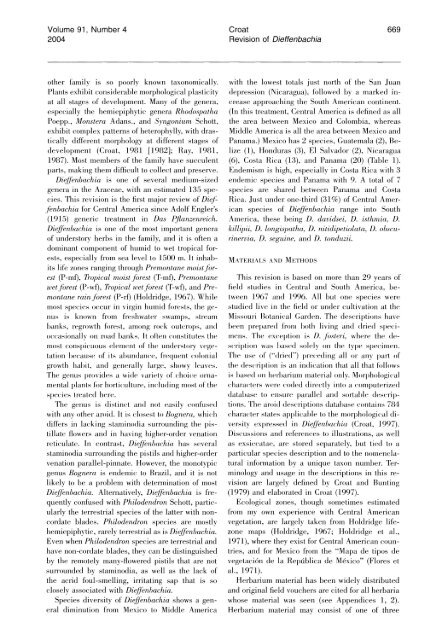l - CNCFlora
l - CNCFlora
l - CNCFlora
Create successful ePaper yourself
Turn your PDF publications into a flip-book with our unique Google optimized e-Paper software.
Volume 91, Number 4<br />
2004<br />
Croat<br />
Revision of Dieffenbachia<br />
other family is so poorly known taxonomically. with the lowest totals just north of the San Juan<br />
Plants exhibit considerable morphological plasticity depression (Nicaragua), followed by a marked inat<br />
all stages of development. Many of the genera, crease approaching the South American continent.<br />
especially the hemiepiphytic genera Rhodospatha (In this treatment, Central America is defined as all<br />
Poepp., Monstera Adans., and Syngonium Schott, the area between Mexico and Colombia, whereas<br />
exhibit complex patterns of heterophylly, with dras- Middle America is all the area between Mexico and<br />
tically different morphology at different stages of Panama.) Mexico has 2 species, Guatemala (2), Bedevelopment<br />
(Croat, 1981 [1982]; Ray, 1981, lize (1), Honduras (3), E1 Salvador (2), Nicaragua<br />
1987). Most members of the family have succulent (6), Costa Rica (13), and Panama (20) (Table 1).<br />
parts, making them difficult to collect and preserve. Endemism is high, especially in Costa Rica with 3<br />
Dieffenbachia is one of several medium-sized endemic species and Panama with 9. A total of 7<br />
genera in the Araceae, with an estimated 135 spe- species are shared between Panama and Costa<br />
cies. This revision is the first major review of Dief- Rica. Just under one-third (31Wo) of Central Amerfenbachia<br />
for Central America since Adolf Engler's ican species of Dieffenbachia range into South<br />
(1915) generic treatment in Das Pf anzenreich. America, these being D. davidsei, D. isthmia, D.<br />
Dieffenbachia is one of the most important genera killipii, D. Iongispatha, D. nitidipetiolata, D. obscuof<br />
understory herbs in the family, and it is often a<br />
dominant component of humid to wet tropical forrinervia,<br />
D. seguine, and D. tonduzii.<br />
ests, especially from sea level to 1500 m. It inhabits<br />
life zones ranging through Premontane moist for-<br />
MATERIALS AND METHODS<br />
est (P-mf), Tropical moist forest (T-mf), Premontane This revision is based on more than 29 years of<br />
wet forest (P-wf), Tropical wet fore.st (T-wf), and Pre- field studies in Central and South America, bemontane<br />
rain forest (P-rf) (Holdridge, 1967). While tween 1967 and 1996. All but one species were<br />
most spevies occur in virgin humid forests, the ge- studied live in the field or under cultivation at the<br />
nus is known from freshwater swamps, stream Missouri lAotani(al Garden. The descriptions have<br />
tanks, reglowth forest, among lo(k out(rosX aIl(l I)een prepale(l flom }oth living and drie(l spe(io(easionally<br />
on roa(l l)anks. It often ( onstitutes the mens. The ex(el)tion is D. fo.steri, where the demost<br />
tonsl)i(uous elelllent of the un(lelstoly vege- s(ril)tioll was lase(l solely on the tyl)e sI)e(inen.<br />
tation })e(ause of its a}un(la-l(e, fe(luellt (olollial rRle use of ("(llie(l") pre(e(lillg a11 or any lart of<br />
glowth 11a}it, an(l genelully ]aIge, showy leaves. the des( ril)tioll is an in(lie ation tllat a11 that follows<br />
The genus t)IOVi4eS a wi(lP valiely of (hoi(e orlla- is lase(l oll let })al iuln nlatel ial ollly. Mol l)hologi( al<br />
mental plants for horti( ulture, in( lu(ling nlost of the (hala(tes wee *o(le(l dire(tly into a (oml)uterize(l<br />
ST)et ieS treate,(l he,l e.<br />
data})ase to ensule parallel an(l sortal)le (lescriy)-<br />
The genus is (listine t an(l not easily ( onfuse(l tions. 'I'he aloi(l dese liptions (latalease ( ontains 72J4<br />
with any other aroi(l. It is ( losest to Bog7lera, whie h c halae tel states aplicable to the morphologie al didiffers<br />
in la(king staminodia sulrounding the pis- versity exlesse(l in DiefWenh(leSli(l (Croat, 1997).<br />
tillate flowers and in having higher-order venation Dis(ussions and references to illustrations, as well<br />
reticulate. In contrast, Dieffenb(lchi(l has several as exsi(catae, are stored separately, but tie(l to a<br />
staminodia surrounding the pistils and higher-order particular spee ies description and to the nomenclavenation<br />
parallel-pinnate. However, the monotypic tural information by a unique taxon number. Tergenus<br />
Bognera is endemie to Brazil, and it is not minology and usage in the descriptions in this relikely<br />
to be a problem with determination of most vision are largely defined by Croat and Bunting<br />
Dieffenbachia. Alternatively, DiefJenbachia is fre- (1979) and elaborated in Croat (1997).<br />
quently confused with Philodendron Schott, partic- Ecological zones, though sometimes estimated<br />
ularly the terrestrial species of the latter with non- from my own experience with Central American<br />
cordate blades. Philodendron species are mostly vegetation, are largely taken from Holdridge lifehemiepiphytic,<br />
rarely terrestrial as is Dieffenbachia. zone maps (Holdridge, 1967; Holdridge et al.,<br />
Even when Philodendron species are terrestrial and 1971), where they exist for Central American counhave<br />
non-cordate blades, they can be distinguished tries, and for Mexico from the "Mapa de tipos de<br />
by the remotely many-flowered pistils that are not vegetacion de la Republica de Mexico" (Flores et<br />
surrounded by staminodia, as well as the lack of al., 1971).<br />
the acrid foul-smelling, irritating sap that is so Herbarium material has been widely distributed<br />
closely associated with Dieffenbachia.<br />
and original field vouchers are cited for all herbaria<br />
Species diversity of Dieffenbachia shows a gen- whose material was seen (see Appendices 1, 2).<br />
eral diminution from Mexico to Middle America Herbarium material may consist of one of three<br />
669

















